LeetCode刷题day27——单调栈
单调栈这里练习5道题,接雨水这题挺有意思的,没接触过这种做法。
739. 每日温度
(https://leetcode.cn/problems/daily-temperatures/)
给定一个整数数组 temperatures ,表示每天的温度,返回一个数组 answer ,其中 answer[i] 是指对于第 i 天,下一个更高温度出现在几天后。如果气温在这之后都不会升高,请在该位置用 0 来代替。
示例 1:
输入: temperatures = [73,74,75,71,69,72,76,73]
输出: [1,1,4,2,1,1,0,0]
示例 2:
输入: temperatures = [30,40,50,60]
输出: [1,1,1,0]
示例 3:
输入: temperatures = [30,60,90]
输出: [1,1,0]
提示:
1 <= temperatures.length <= 10530 <= temperatures[i] <= 100
分析:
暴力解法搞不定,最后一个样例时间超限。我观察了,发现这个测试数据是每一轮都跑到了最后,导致时间复杂度真正到了n^2。
class Solution {
public:
vector<int> dailyTemperatures(vector<int>& temperatures) {
vector<int> result(temperatures.size(), 0);
for (int i = 0; i < temperatures.size(); i++) {
int j = i + 1;
while (j < temperatures.size() &&
temperatures[j] <= temperatures[i]) {
j++;
}
if (j == temperatures.size())
result[i] = 0;
else
result[i] = j - i;
}
return result;
}
};
单调栈是:加入的元素是单调的,一旦遇到不是单调的那个元素,就开始处理,弹栈。单调栈可以用在一个数组,求某个元素右边第一个比他大/小的元素。
class Solution {
public:
vector<int> dailyTemperatures(vector<int>& temperatures) {
//单调栈:每次加入元素下标。要求:求出右边第一个比自己大的元素?即将入栈元素与栈顶元素比较大小,如果即将入站元素比栈顶大,找到了!!!处理结果数组,然后弹出栈顶,继续比较。直到栈顶元素大于此元素,将此元素入栈。
vector<int> result(temperatures.size(), 0);
stack<int> s;
s.push(0);
for (int i = 1; i < temperatures.size(); i++) {
while (!s.empty() && temperatures[i] > temperatures[s.top()]) {
result[s.top()] = i - s.top();
s.pop();
}
s.push(i);
}
return result;
}
};
496. 下一个更大元素 I
(https://leetcode.cn/problems/next-greater-element-i/)
nums1 中数字 x 的 下一个更大元素 是指 x 在 nums2 中对应位置 右侧 的 第一个 比 x 大的元素。
给你两个 没有重复元素 的数组 nums1 和 nums2 ,下标从 0 开始计数,其中nums1 是 nums2 的子集。
对于每个 0 <= i < nums1.length ,找出满足 nums1[i] == nums2[j] 的下标 j ,并且在 nums2 确定 nums2[j] 的 下一个更大元素 。如果不存在下一个更大元素,那么本次查询的答案是 -1 。
返回一个长度为 nums1.length 的数组 ans 作为答案,满足 ans[i] 是如上所述的 下一个更大元素 。
示例 1:
输入:nums1 = [4,1,2], nums2 = [1,3,4,2].
输出:[-1,3,-1]
解释:nums1 中每个值的下一个更大元素如下所述:
- 4 ,用加粗斜体标识,nums2 = [1,3,4,2]。不存在下一个更大元素,所以答案是 -1 。
- 1 ,用加粗斜体标识,nums2 = [1,3,4,2]。下一个更大元素是 3 。
- 2 ,用加粗斜体标识,nums2 = [1,3,4,2]。不存在下一个更大元素,所以答案是 -1 。
示例 2:
输入:nums1 = [2,4], nums2 = [1,2,3,4].
输出:[3,-1]
解释:nums1 中每个值的下一个更大元素如下所述:
- 2 ,用加粗斜体标识,nums2 = [1,2,3,4]。下一个更大元素是 3 。
- 4 ,用加粗斜体标识,nums2 = [1,2,3,4]。不存在下一个更大元素,所以答案是 -1 。
提示:
1 <= nums1.length <= nums2.length <= 10000 <= nums1[i], nums2[i] <= 104nums1和nums2中所有整数 互不相同nums1中的所有整数同样出现在nums2中
**进阶:**你可以设计一个时间复杂度为 O(nums1.length + nums2.length) 的解决方案吗?
分析:
class Solution {
public:
vector<int> nextGreaterElement(vector<int>& nums1, vector<int>& nums2) {
vector<int> res;
for (int i = 0; i < nums1.size(); i++) {
int index=0;
for(int j=0; j<nums2.size(); j++) {//找到nums1在Nums2中对应的下标
if(nums2[j]==nums1[i]) {
index=j;
break;
}
}
int j=index;//下标找到,开始处理:找下一个更大的元素
for(; j<nums2.size(); j++) {
if(nums2[j]>nums2[index]) {
res.push_back(nums2[j]);
break;
}
}
if(j==nums2.size())
res.push_back(-1);
}
return res;
}
};
503. 下一个更大元素 II
(https://leetcode.cn/problems/next-greater-element-ii/)
给定一个循环数组 nums ( nums[nums.length - 1] 的下一个元素是 nums[0] ),返回 nums 中每个元素的 下一个更大元素 。
数字 x 的 下一个更大的元素 是按数组遍历顺序,这个数字之后的第一个比它更大的数,这意味着你应该循环地搜索它的下一个更大的数。如果不存在,则输出 -1 。
示例 1:
输入: nums = [1,2,1]
输出: [2,-1,2]
解释: 第一个 1 的下一个更大的数是 2;
数字 2 找不到下一个更大的数;
第二个 1 的下一个最大的数需要循环搜索,结果也是 2。
示例 2:
输入: nums = [1,2,3,4,3]
输出: [2,3,4,-1,4]
提示:
1 <= nums.length <= 104-109 <= nums[i] <= 109
分析:
这题和上题的变化是:循环。可以找一圈,简单的想法是把数组复制一份拼在一起,遍历两倍数组的长度即可。注意观察代码,就是经典单调栈的写法,只是在循环条件上做了取模操作。
class Solution {
public:
vector<int> nextGreaterElements(vector<int>& nums) {
stack<int> s;
vector<int> res(nums.size(), -1);
s.push(0);
for (int i = 1; i < nums.size()*2; i++) {//长度取两倍
while(!s.empty()&&nums[i%nums.size()]>nums[s.top()]) {//下标还在范围内跑动
res[s.top()] = nums[i%nums.size()];
s.pop();
}
s.push(i%nums.size());
}
return res;
}
};
42. 接雨水
(https://leetcode.cn/problems/trapping-rain-water/)
给定 n 个非负整数表示每个宽度为 1 的柱子的高度图,计算按此排列的柱子,下雨之后能接多少雨水。
示例 1:
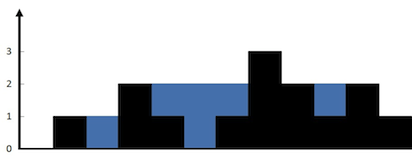
输入:height = [0,1,0,2,1,0,1,3,2,1,2,1]
输出:6
解释:上面是由数组 [0,1,0,2,1,0,1,3,2,1,2,1] 表示的高度图,在这种情况下,可以接 6 个单位的雨水(蓝色部分表示雨水)。
示例 2:
输入:height = [4,2,0,3,2,5]
输出:9
提示:
n == height.length1 <= n <= 2 * 1040 <= height[i] <= 105
分析:
先来暴力解法:按列算,暴力解法无法通过。321 / 324 个通过的测试用例。
- 思路一:暴力法。竖向每一个位置都查看,此位置能装多少雨水。以自己为底
mid,向左找到最大的高度lheight,向右找到最大的高度rheight,此位置i能装的水为:h = min(lheight,rheight)-height[i];第一个和最后一个不能装雨水,跳过。
class Solution {
public:
int trap(vector<int>& height) {
int res = 0;
for(int i=0;i<height.size();i++) {
if(i==0||i==height.size()-1) continue;
int lheight = 0;
int rheight = 0;
for(int j=0;j<i;j++)
lheight = max(lheight,height[j]);
for(int j=i+1;j<height.size();j++)
rheight = max(rheight,height[j]);
int h = min(lheight,rheight)-height[i];
if(h>0)
res+=h;
}
return res;
}
};
- 思路二:双指针法。按列算,先各自算出左右两边的最大高度。
class Solution {
public:
int trap(vector<int>& height) {
int res = 0;
vector<int> right(height.size(),0);
vector<int> left(height.size(),0);
left[0] = height[0];
//各自先计算
for (int i = 1; i < height.size(); i++) {
left[i] = max(height[i],left[i-1]);
}
right[height.size()-1] = height[height.size()-1];
for(int i=height.size()-2;i>=0;i--) {
right[i] = max(height[i],right[i+1]);
}
for(int i=0;i<height.size();i++) {
int h = min(left[i],right[i])-height[i];
if(h>0) {
res+=h;
}
}
return res;
}
};
- 思路三:单调栈法,用栈里的两个元素,作为左,底,待入栈元素作为右。按行算。图为代码随想录复制,如水印所示。
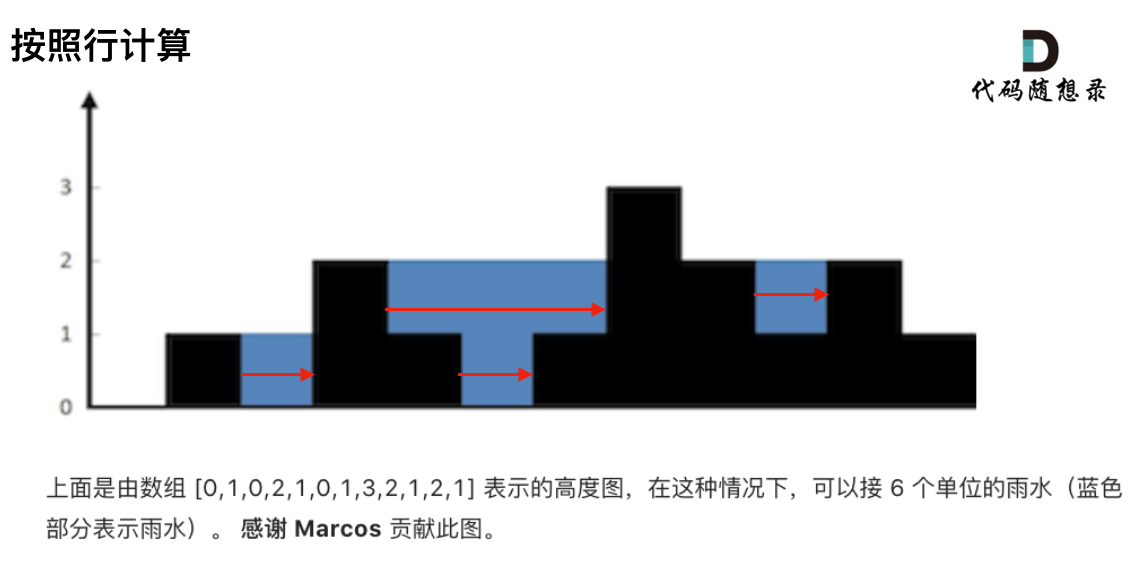
class Solution {
public:
int trap(vector<int>& height) {
int res=0;
stack<int> s;
s.push(0);
for(int i=1;i<height.size();i++) {
while(!s.empty()&&height[i]>height[s.top()]) {
int mid = s.top();//底
s.pop();
if(!s.empty()) {
int left = s.top();//左
int w = i-left-1;//右-左-1 得到宽度
int h=min(height[i],height[left])-height[mid];
res+=h*w;
}
}
s.push(i);
}
return res;
}
};
84. 柱状图中最大的矩形
(https://leetcode.cn/problems/largest-rectangle-in-histogram/)
给定 n 个非负整数,用来表示柱状图中各个柱子的高度。每个柱子彼此相邻,且宽度为 1 。
求在该柱状图中,能够勾勒出来的矩形的最大面积。
示例 1:
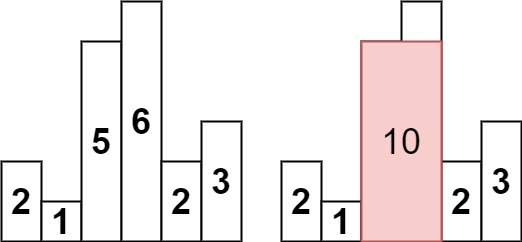
输入:heights = [2,1,5,6,2,3]
输出:10
解释:最大的矩形为图中红色区域,面积为 10
示例 2:
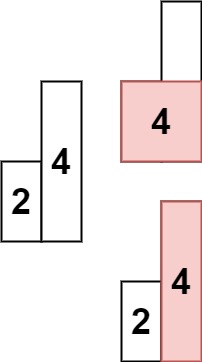
输入: heights = [2,4]
输出: 4
提示:
1 <= heights.length <=1050 <= heights[i] <= 104
分析:
暴力法,时间超限, 89 / 99 个通过的测试用例。
-
为此,我们需要:
左边看一下,看最多能向左延伸多长,找到大于等于当前柱形高度的最左边元素的下标;
右边看一下,看最多能向右延伸多长;找到大于等于当前柱形高度的最右边元素的下标。
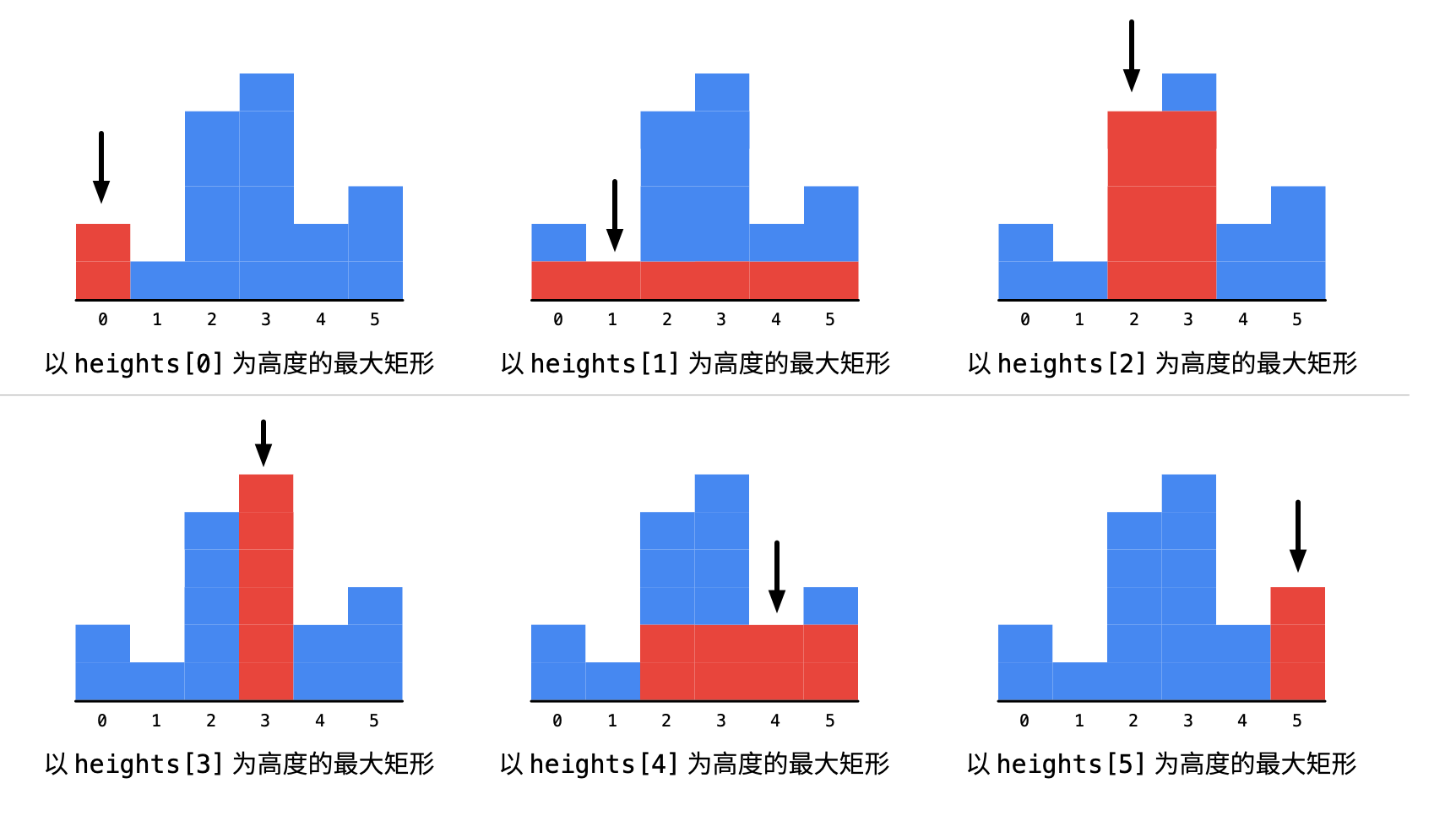
图片是LeetCode里的,作者是liweiwei1419。
class Solution {
public:
int largestRectangleArea(vector<int>& heights) {
int res=0;
for(int i=0;i<heights.size();i++){
int left=i;
int right=i;
for(;left>=0;left--)
if(heights[left]<heights[i])
break;
for(;right<heights.size();right++)
if(heights[right]<heights[i])
break;
int w=right-left-1;
int h=heights[i];
res=max(res,h*w);
}
return res;
}
};
- 单调栈法:不管哪个方法,我们都是要找到位置
mid为基准,左边第一个比它小,右边第一个比它小的位置。宽度就是:w = right - left - 1; S = w * heights[mid]。这个单调栈是栈头到栈底是递减的。
class Solution {
public:
int largestRectangleArea(vector<int>& heights) {
int res = 0;
stack<int> st;
heights.push_back(0);
heights.insert(heights.begin(), 0);
for (int i = 0; i < heights.size(); i++) {
while (!st.empty() &&heights[st.top()] > heights[i]) {
int mid = st.top();
st.pop();
if (!st.empty()) {
int left = st.top();
int w = i - left - 1;
int h = heights[mid];
res = max(res, w * h);
}
}
st.push(i);
}
return res;
}
};























 471
471

 被折叠的 条评论
为什么被折叠?
被折叠的 条评论
为什么被折叠?








